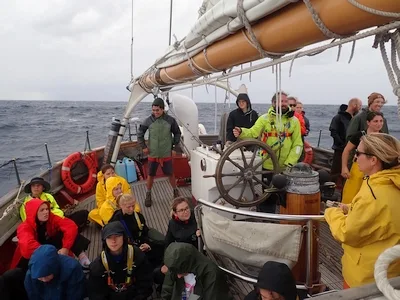News
Learning Our Lines

Ship’s Log
Noon Position
38° 21.1’N x 062°12.0’ W
Ship Heading
Hove to for Science!
Ship Speed
Hove to
Taffrail Log
779.0 nm
Weather / Wind / Sail Plan
A mix of heavy rain and sunshine, Waves of 8 feet in height from the NNW / Wind of force 6 from the NNW / Main and Fore Stay s’ls Description of location: (e.g. 100 nm SE of Newfoundland over Georges Bank!): Middle of nowhere, or 370 nm NE x N of Bermuda (our closest landmass).
From the day we step foot on the boat, we began our journey to becoming sailors. This included learning the 50+ lines used for sailing and science, where they are and what they are for. (And yes there really are that many, I counted). But what is a line? A line is simply a rope with a purpose, as our lovely crew has put it. They are how we set and strike sails, but also how we deploy and retrieve a lot of scientific equipment.
“How do you memorize so many lines so quickly?” you may ask. It’s simple really; divide a bunch of young adults into watches and pit them against each other for a (mostly) friendly competition. This competition was today’s main event-the Line Chase.
 Students (Kayla, Camilla, Allen and Alec with scientists Jordan and Kathrine) cheering on their fellow watch members
Students (Kayla, Camilla, Allen and Alec with scientists Jordan and Kathrine) cheering on their fellow watch members
What is the Line Chase? A relay race, of course! Each watch is assigned a crew member from a different watch, who gives them a series of flashcards one by one, and the first watch to go through the whole stack of cards wins! We do have some rules to make it a little more interesting though.
 Students (Brier, Taylor, Stephanie, and Zuzanna with crew member Matt) putting their line knowledge to use and handling sails.
Students (Brier, Taylor, Stephanie, and Zuzanna with crew member Matt) putting their line knowledge to use and handling sails.
Rule 1: No directions! (This includes pointing!) The only way you may advise your teammate who is actively looking for a line is with the hot and cold system. Rule 2: No running! The boat rocks with the swells of the waves and with a slippery deck, running is much too dangerous. If you are caught running you must finish your turn by crab walking backwards. (Although thankfully and sadly we did not have anyone crab walking today.) But who won? Sadly I must report A watch finished first, with B watch finishing only seconds behind. C watch followed not to long after, ending the competition after only a whopping 17 minutes! We have all come so far within the past week or so to get us to this point, but we still have so much to learn, and I, for one, am excited for it.
Best wishes,
Kayla Davis, B Watch, Eckerd College
P.S. To my family and friends, I’m not 100% sure if I even told you about this blog, but if you’re reading this I love and miss you. Don’t worry too much I’m having fun and can’t wait to tell you all about it.
P.P.S. And for those who may not believe just how many lines we have to learn here is an abbreviated list of those involved with just the sails we use most: Mains’l Halyard, Mains’l Downhaul, Mails’l Sheet, Mains’l Jigger, Topping lift for the Main Boom, Preventer, Deep Reef Tack, Deep Reef Clew Outhaul, Shallow Reef Tack, Shallow Reef Clew Outhaul; Mainstays’l Haylard, Manistays’l Downhaul, Mainstays’l Sheet, Mainstays’l Traveller Outhaul (there are two, one on each side), Mainstays’l Jigger, Forestays’l Halyard, Forestays’l Downhaul, Forestays’l sheet, Forestays’l Traveller Outhaul (again one on each side), Forestays’l Jigger, Top Braces (one each side) and Course Braces (again one each side). And this doesn’t include any lines for the other sails-Jib, Jib Tops’l, Fisherman, Tops’l and Course- the science lines or any of the other random lines not for sail handling or science.
